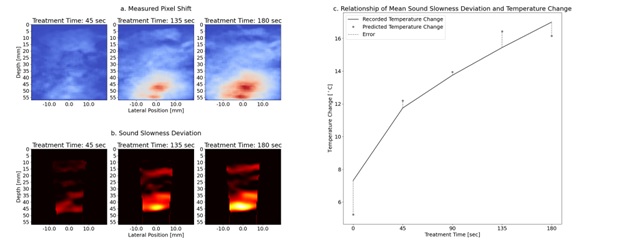In ultrasound imaging, the speed of sound is used to create images of internal structures within
the body. The speed of sound in tissue is dependent on the density and elasticity of the tissue.
Ultrasound transducer emits sound waves, which travel through the body at a specific speed
and are reflected back to the transducer. The time it takes for the sound waves to travel through
the tissue and return to the transducer is used to calculate the depth of the tissue and create a
two-dimensional image. While standard ultrasound images display the echo amplitude across a
field of view, we develop new imaging protocols to calculate the pixel-wise speed-of-sound, and
evaluate the pixel-shift change when physiological effects that influence the speed-of-sound are
introduced.
One example is ultrasonic thermometry where the distortion is caused by localized thermal
ablation. The speed-of-sound change can be measured by comparing the acquired RF echo to
a reference to provide valuable insights into the effects of ablation on tissue over time. We use
ultrasonic thermometry side-by-side with therapeutic ultrasound to create a robust ultrasound
guided focused ultrasound system. The algorithm is implemented using the imaging transducer
to monitor such a therapy and provide live thermometry feedback.

